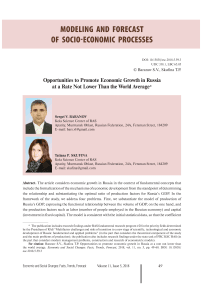Opportunities to promote economic growth in Russia at a rate not lower than the world average
Автор: Baranov Sergei V., Skufina Tatiana P.
Журнал: Economic and Social Changes: Facts, Trends, Forecast @volnc-esc-en
Рубрика: Modeling and forecast of socio-economic processes
Статья в выпуске: 5 (59) т.11, 2018 года.
Бесплатный доступ
The article considers economic growth in Russia in the context of fundamental concepts that include the formalization of the mechanisms of economic development from the standpoint of determining the relationship and substantiating the optimal ratio of production factors for Russia’s GDP. In the framework of the study, we address four problems. First, we substantiate the model of production of Russia’s GDP, expressing the functional relationship between the volume of GDP, on the one hand, and the production factors such as labor (number of people employed in the Russian economy) and capital (investment in fixed capital). The model is consistent with the initial statistical data, so that the coefficient of determination between the model data and real data is more than 99%. Second, we substantiate the optimal ratio between investment and employment for the purpose of increasing Russia’s GDP. Third, we analyze in detail how these optimal ratios correspond to the real processes of GDP production...
Russia, economic growth, modeling, gross domestic product, labor, capital, optimal ratios
Короткий адрес: https://sciup.org/147224100
IDR: 147224100 | DOI: 10.15838/esc.2018.5.59.3
Список литературы Opportunities to promote economic growth in Russia at a rate not lower than the world average
- Mau V. Waiting for a new model of growth: Russia’s social and economic development in 2013. Voprosy ekonomiki=Issues of Economics, 2014, no. 2, p. 21..
- Maevskii V.I., Malkov S.Yu., Rubinshtein A.A. Analysis of the economic dynamics of the US, the USSR and Russia with the help of the SMR-model. Voprosy ekonomiki=Issues of Economics, 2018, no. 7, pp. 82-95..
- Akindinova N.V., Chekina K.S., Yarkin A.M. Measuring the contribution of demographic change and human capital to economic growth in Russia Ekonomicheskii zhurnal VShE=HSE Economic Journal, 2017, no. 4 (21), pp. 533-561..
- Ilyin V.A., Morev M.V. What will Putin bequeath to his successor in 2024? Ekonomicheskie i sotsial’nye peremeny: fakty, tendentsii, prognoz=Economic and Social Changes: Facts, Trends, Forecast, 2018, vol. 11, no. 1, pp. 9-31..
- Minakir P.A. "Decree" economy. Prostranstvennaya ekonomika=Spatial Economics, 2018, no. 2, pp. 8-16..
- Rodrik D. Diagnostics before prescription. Journal of Economic Perspectives, 2010, vol. 24 (3), pp. 33-44.
- Hausmann R., Klinger B. Growth Diagnostic: Belize. Harvard: Center for International Development Harvard University, 2007. 43 p.
- Robinson J., Acemoglu D., Johnson S. Institutions as a fundamental cause of long-run growth. In: Aghion P. (Ed.). Handbook of Economic Growth. Amsterdam: Elsevier, North Holland, 2005. Vol. 1. Pp. 386-472.
- Greenwood J., Zvi H., Per K. Long-Run implications of investment-specific technological change. American Economic Review, 1997, no. 87 (3), June, pp. 342-362.
- Nicola P.C. Mainstream Mathematical Economics in the 20th Century. Springer Science & Business Media, 2013. 527 p.
- Cobb C.W., Douglas P.H. A theory of production. American Economic Review, 1928, 18 (supplement), pp. 139-165.
- Blaug M. Economic Theory in Retrospect. 5th edition. Cambridge: Cambridge University Press, 1997. Pp. 544-546.
- Houthakker H.S. The Pareto distribution and the Cobb-Douglas production function in activity analysis. Review of Economic Studies, 1955, vol. 23 (1), pp. 27-31.
- Duffy J., Papageorgiou C. A Cross-country empirical investigation of the aggregate production function specification. Journal of Economic Growth, 2000, vol. 5 (1), pp. 87-120.
- Mallick D. The role of the elasticity of substitution in economic growth: a cross-country investigation. Labour Economics, 2012, vol. 19(5), pp. 682-694.
- La Grandville O., Klump R. Economic growth and the elasticity of substitution: two theorems and some suggestions. American Economic Review, 2000, vol. 90 (1), pp. 282-291.
- Antras P. Is the US aggregate production function Cobb-Douglas? New estimates of the elasticity of substitution. Journal of Macroeconomics, 2004, vol. 4(1), pp. 1-36.
- Karabarbounis L., Neiman B. The global decline of the labor share. The Quarterly Journal of Economics, 2014, vol. 129 (1), pp. 61-103.
- Jones I. The facts of economic growth. Handbook of Macroeconomics, 2016, vol. 2, pp. 3-69.
- Hsieh C.T., Klenow P.J. Development accounting. American Economic Journal: Macroeconomics, 2010, vol. 2 (1), pp. 20-23.
- Skufina Т., Baranov S, Samarina V., Shatalova T. Production functions in identifying the specifics of producing gross regional product of Russian Federation. Mediterranean Journal of Social Sciences, 2015, vol. 6 (5), pр. 265-270.
- Skufina T.P., Baranov S.V., Korchak E.A. Impact assessment of investment dynamics on the growth of the gross regional product in the regions of the North and the Arctic Zone of the Russian Federation. Voprosy statistiki=Issues of Statistics, 2018, no. 6, pp. 25-35..
- Felipe J., Adams F. G. A theory of production: the estimation of the Cobb-Douglas function: a retrospective view. Eastern Economic Journal, 2005, vol. 31 (3), pp. 427-445.
- Kolemaev V.A. Ekonomiko-matematicheskoe modelirovanie . Moscow: YuNITI-DANA, 2002. 399 p.
- Methodological provisions on statistics. Available at: http://www.gks.ru/bgd/free/B99_10/IssWWW.exe/Stg/d000/i000080r.htm (accessed: 8.08.2018)..


